Executive Summary
While early adopters of the assets-under-management (AUM) model got started in the late 1980s or early 1990s, the model only really began to become widely adopted in the early 2000s. Yet as the AUM model has become increasingly popular, and firms have had time to build, the “typical” advisory firm has grown significantly, from an average of only $25M of AUM in 2002 to more than $200M of AUM in 2013. And with an average profit margin of about 22%, the typical advisory firm owner with an AUM practice is enjoying record take-home pay.
Yet the caveat is that as advisory firms on the AUM model have grown, their growth rates seem to be slowing, a combination of both the ongoing crisis of differentiation for advisory firms, and the simple fact that as the firm gets bigger the denominator of the growth rate fraction is difficult to overcome; after all, adding “just” $4M of new assets a decade ago would have been double-digit organic growth, yet the same new asset flows yielded barely a 4% growth rate for a typical firm in 2009 and would be less than a 2% growth rate for the average firm today!
The significant danger of this situation is that advisory firms with now-low growth rates will not be able to grow through the next bear market as they have in the past. And in fact, at an average profit margin of “just” 22% and the risk that the next bear market could lop off 25% or more from a firm’s assets and revenue, the reality is that not all advisory firms may even survive the next downturn! Or at least, not without laying off significant staff or forcing owners to stop taking any profits and actually plow money back into the firm just to ensure its survival. To say the least, the next bear market may be the worst one ever for advisors and their firms!
These risks – which seem somewhat inevitable, given that a market downturn will eventually happen, and so many advisory firms are too large to just grow their way through it – mean advisory firms should be focusing, now, on whether they have sufficient flexibility to their overhead costs, other means to stabilize revenues, or enough profit margins to absorb the next market decline when it comes. While many have been critical that advisory firms are “too profitable” and due for some competition in today’s environment, the reality is that judging profit margins after a 5-year bull market may not be the best measure, and in fact the greatest risk for most firms may be that their profit margins are still too small to withstand the next bear market when it comes along!
The Role Of Profit Margins In An Advisory Firm
Monitoring profit margins is crucial for an advisory firm. But the point of profit margins for the firm isn’t just about the amount of profit that the owners can extract from the business; profit margins are also an important line of defense for an advisory firm facing a decline in revenue when a bear market occurs.
From the peak in mid-2000 to the trough in 2002, maintaining the revenue of an advisory firm through the 2-year duration of the bear market wasn’t all THAT difficult, though. With $25M of AUM, losing almost 25% (in a diversified portfolio) from top to bottom was only a loss of about $6M of AUM. If the advisor merely added half a dozen clients per year with $500k each, the business AUM and revenue remained stable (assuming existing clients were retained). The only decline in profit margins was due to firms that were so effective at growing, despite the bear market, that they continued to hire through 2001 and 2002. In other words, it wasn’t even necessarily to rely on profit margins as a buffer to market volatility, because growth alone was sufficient (and quite achievable) to fully mitigate the effect.
By 2008, the stakes were higher. A typical advisory firm by then was just over $100M of AUM and had two partners; now a 25% decline in the diversified portfolios was a $25M loss, and most of the losses came in the span of less than a year from the fall of 2008 to the spring of 2009. This time, advisory firms struggled to keep up; replacing $25M in a year would require two partners to each bring in $1M of new assets, per month, all year long, amidst a traumatic bear market… not to mention serving all the existing (and highly stressed!) clients as well!
The end result in the 2008 bear market: many advisory firms saw, for the first time, a decline in annual revenue in 2009 (after a tepid year in 2008), and what amounted to a significant step back in annualized revenue projections from the prior peak in the 3rd quarter of 2007. Between declining assets from market returns, possible client attrition, pressure on fees, and the fact that there were more retired clients taking withdrawals (rather than accumulators who would keep saving into accounts), it just wasn’t feasible for most advisory firms to grow through the bear market. In other words, growth alone was no longer a sufficient defense to market volatility for the advisory firm owner; profit margins had to play a role, too.
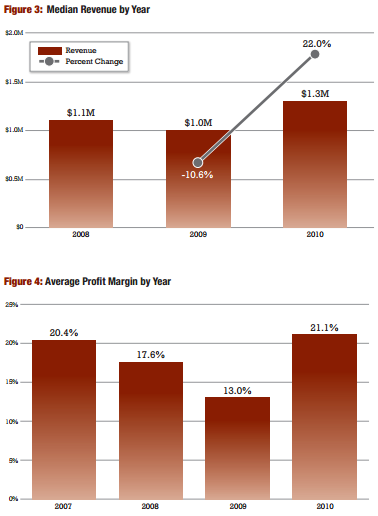
Source: 2011 InvestmentNews/Moss Adams Adviser Compensation & Staffing Study
Fortunately though, as the graphic above shows, the reality is that firms in 2008 has healthy enough profit margins that the decline in revenue didn’t actually “blow up” many firms; it simply compressed their profit margins. As a result, 2009 was a “record low” of only 13% profit margins for advisory firms. But they weathered the storm.
The Tyranny Of The AUM Denominator On Advisory Firm Growth Rates
Since the market trough in 2009, the average advisory firm has grown significantly once again. Under the Moss Adams 2013 Compensation And Staffing Benchmarking Study, the average advisory firm by then had grown to more than $200M of AUM by the end of 2012, with at least two partners, and a staff of 7. The good news is that this continued to boost the income of advisory firm owners. The bad news, however, is that as the base of assets grows bigger, firms are finding it harder and harder to sustain their growth rates, as the denominator for growth becomes larger and larger.
For instance, the average advisory firm heading into 2003 could achieve 12% organic growth by just adding half a dozen clients with $500k each, growing by $3M of new assets on a $25M base. In 2013, a 12% organic growth rate for the now-$200M firm would require a new millionaire every other week all year long – in an environment that’s more competitive than ever, as all the other $200M+ advisory firms are trying to achieve the same growth rates even while the number of millionaire households is barely larger than where it was in 2007!
Overall, the recent Investment News 2014 study on Financial Performance of Advisory Firms shows that for the past 5 years, advisory firms have enjoyed significant AUM growth, with double-digit growth rates for four of the past 5 years (stumbling only slightly with the market volatility of 2011).
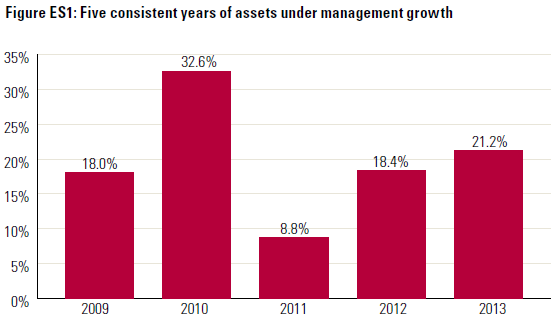
Source: 2014 InvestmentNews Study Of Financial Performance Of Advisory Firms
However, the reality is that the market growth of the past 5 years has also been quite generous – which means a significant portion of overall AUM growth has actually just been the market tailwind! If we assume advisory firms themselves generate the returns of a diversified portfolio and back those market returns out for the past 5 years, we arrive at the following chart of annual organic growth rates. (Michael’s Note: “Market Returns” for this analysis were assumed to be a “60/40” portfolio, comprised of 30% S&P 500, 15% Russell 2000, 15% EAFE, 25% Barclays Aggregate Bond, 10% Intermediate Government Bonds, and 5% Treasury Bills.)
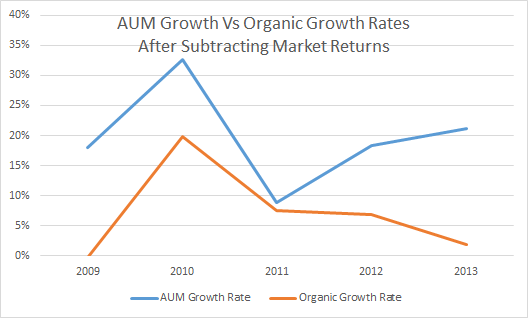
As the chart reveals, once market returns are backed out, growth of advisory firms has been far more erratic than the steady AUM growth charts of the industry studies implied. 2009 was a virtually flat year, as clients remained locked in place (shell-shocked after the market crash?); it was only in 2010 that clients began to really move and change (to) advisors. In 2011 and 2012 the growth rates continued, but at a greatly diminished rate relative to 2010.
By 2013, however, growth rates had fallen dramatically, a combination perhaps of investor complacency (less pressure to move to a new advisor after 5 years into a bull market?) and the fact that advisory firms had grown so much that the growth fraction continued to decline as the denominator rose; in other words, the actual dollar amount increase in AUM in 2013 that produced a less-than-2% growth rate in 2013 would have been nearly a 4% growth rate in 2009, and a 14% growth rate back in 2002 (back when growth was against “just” a $25M base!)!
And notably, the chart here still overstates the amount of true organic growth for firms, given that there has been at least some inorganic growth through mergers and acquisitions amongst advisory firms (which is implicitly included in the growth rates above). Thus, the true flow of organic growth averaged across advisory firm – through new assets from existing clients, and the acquisition of new clients – is even lower than these charts imply!
What Happens When The Next Bear Market Comes?
The reason all this matters is that in today’s environment, advisory firms are now so large that not only is organic growth not realistically capable of sustaining the firm through a bear market (as the growth that produced double-digit growth rates a decade ago can’t even produce a 2% growth rate today), but profit margins aren’t necessarily wide enough to sustain the impact for many advisory firms, either.
Across the entire industry, the latest Investment News study found that the average operating income of an advisory firm was 24%, which – even at a 0% organic growth rate – would be barely sufficient to handle a 25% decline in AUM due to a bear market. However, within advisory firms, the Investment News study found significant variability; while top performing (top 25%) solo firms had profit margins of 42.8%, the rest (the other 75%) were only 20.6%; amongst ensemble firms, the top had 44.5% profit margins, but the rest averaged only 16.5%.
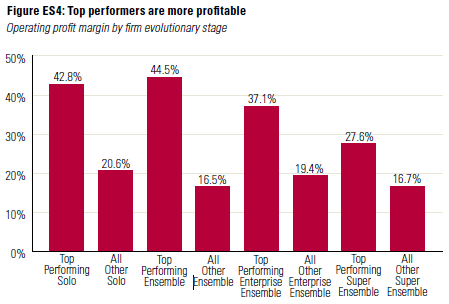
Source: 2014 InvestmentNews Study Of Financial Performance Of Advisory Firms
The significance of this cannot be overstated – it means that as many of 75% of solo and ensemble firms are approaching 0% organic growth rates with 16%-20% profit margins, in a world where even with a diversified base of client portfolios, a bear market can chop AUM and revenue by 25%.
In other words, the next bear market may lead to a drastic wave of staffing cuts and layoffs from independent advisory firms – the larger the firm, the more the fixed overhead expenses, and the greater the risk! – with the possibility that many will just shut their doors and go out of business altogether, or be sold for a tiny pittance (as with negative profit margins in a bear market, the firms would have very limited economic value to a buyer).
To say the least, the next bear market may be the most traumatic ever for owners of advisory firms managing to the potential volatility of their revenue and profits!
Where Should Advisory Firm Owners Go From Here?
So given these prospective challenges to advisory firms that have grown larger than ever – with more overhead than ever – and face a potentially severe business strain in the next recession and bear market that will eventually come, what should be done?
The first option is just to build a larger profit margin buffer into the business to absorb the inevitable market shock whenever it comes. This means taking a hard look at the expenses of the business – now, while the business is not under duress and there is more flexibility to make changes. As the Investment News study clearly shows, firms of a remarkably similar size can and are run with remarkably different profit margins. For many advisors, the viewpoint has been that running smaller profit margins is “ok” because their goal is not necessarily to maximize personal income, and they want to invest into the business itself and/or the quality of the solutions they provide clients. Yet as this analysis makes clear, the reality is that profit margins are about more than just income to owners and reinvestment into the business; an advisory firm’s profit margin is also the buffer to revenue shocks, and running with too small a profit margin can risk the survival of the entire business.
The second option is to buffer the impact of a market downturn by at least making the expenses and overhead of the business more flexible and variable. For instance, staff compensation that is structured as a base salary and a bonus component that is tied to overall firm revenue will naturally reduce staff costs in a market downturn (which is important, as staff compensation is the single largest expense for an advisory firm); even with partial revenue-based compensation, the impact of a downturn will still be more severe to owners than to employees, but a compensation structure that naturally builds in cuts to staff compensation when markets and revenue declines can reduce the need and risk for staff layoffs (or owners being forced to put money into the firm just to keep it afloat). This is especially crucial for the long-term survival of the advisory firm, as client demands tend to spike during market declines, so it is otherwise not a good time to be reducing staff and services! For many advisory firms that already pay employee advisors on a revenue-sharing basis, this structure has already been implemented for their most “expensive” employees (however, for employee advisors with a large book of clients, the firm may have already sacrificed its profit margins putting employee advisors onto revenue-based compensation models in the first place!).
Notably, while some firms have also sought to manage their costs by going through mergers and acquisitions in search of size and scale – and therefore greater profit margins to buffer the business – the Investment News research suggests that firms are not necessarily finding economies of scale, lower overhead costs, and better profit margins, by growing larger. As the graphic from the latest study below shows, operating profit margins for advisory firms remain remarkably consistent in a range from 23% to 27.5% for firms with revenue all the way from $250k/year to $15M/year (and actually declines for the largest super-RIAs, in part because they appear to be reinvesting heavily back into their businesses for future growth, though they may also have access to outside capital to help weather a market downturn). Which means focusing on the profit margin of the firm and how costs are managed – regardless of size – may be a more effective strategy than trying to merge and get larger to achieve economies of scale as a way of managing the risk.
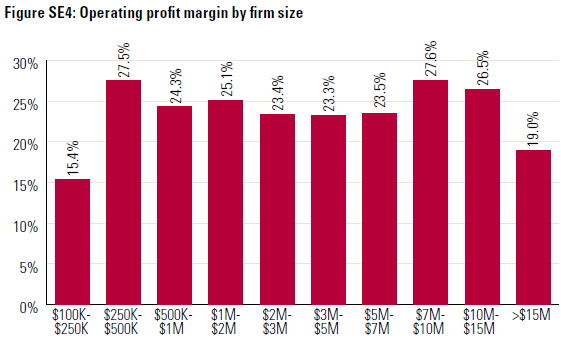
Source: 2014 InvestmentNews Study Of Financial Performance Of Advisory Firms
For some firms, the conclusion may be to try to reduce the volatility of their revenues in the first place, such as transitioning from AUM to retainer fees instead. However, the caveat of the retainer model is that the pricing is much more salient – i.e., clients may become more acutely aware of what they’re paying – at the exact time when they’re most sensitive to their expenses (during a bear market). As a result, it’s not entirely clear whether retainer fees will be any better at managing revenue volatility when the time comes; after all, if a $1M AUM client pays a $10,000 retainer fee (equivalent to 1%) instead, and the market declines by 25%, the next advisory firm up the street that still operates on an AUM basis will be soliciting that client at a 1% x $750k = $7,500 fee, and if the current advisory firm has to match a competitor’s pricing and the retainer fee falls to $7,500, the revenue decline happened anyway! Yet the further problem of a retainer fee is that when the market rebound occurs, the AUM fee will bounce back, but the retainer may be ‘stuck’ at $7,500 (e.g., advisory firm revenues are up more than 100% since 2009, while it’s difficult to imagine a retainer firm enjoying similar growth when the bull markets get underway)! Alternatively, the problem with clients paying retainers who are “locked in” to a $10,000 fees when their portfolio declines may realize they are then paying 1.33% (a $10,000 fee on a $750,000 portfolio), and may decide to leave the advisor altogether. For many firms, it may be preferable to hedge the firm’s revenue by buying put options to protect against a market decline, similar to how a farmer might purchase put options (or commodities futures) to ensure their future revenues at current prices (minus a small cut for the cost of protection).
For a few firms, the strategy may simply be to double down on growth, reinvesting into marketing and capacity-building for the firm, in an effort to “grow through” the next market decline (as many/most firms have done in the past). However, the reality is that most firms spend very little on marketing and business development at all; according to the Investment News research results, it’s an average of only 2.1% of revenues across all firms. And again, due to the sheer size of the firm as it grows, the marketing and business development strategies that were effective in the past are not likely to be enough in the future – especially if business development has previously been built around just one or a few partners who bring in new clients, and attempt to do so at a time when clients tend to hunker down and not make changes for a while (as shown earlier, 2010 was the big year for new clients after the market decline, not 2009 when the market bottomed!). Simply put, there may just not be enough partners/advisors doing business development to grow through a market decline given the size of the firms today! And that’s before considering the challenge that advisory firms overall seem to be struggling more to grow at all in today’s environment, as it is increasingly difficult for firms to differentiate themselves from the competition at all!
Ironically, the “smallest” of firms may actually be the best positioned, as solo proprietors with little overhead may still see a significant personal impact to income, but have far more flexibility and far less overhead to cover amidst a market downturn. In fact, as shown earlier, the Investment News research finds that solo advisory firms have some of the best profit margins, even amongst those that are not “top performers”. Thus, while solo advisory firms are limited in the total size of their income (while solo firms may be profitable, their total profits are limited by the capacity of a single advisor and his/her ability to manage only a limited number of client relationships), they may actually be least exposed to the disruptive impact of a bear market!
The bottom line, though, is simply this: while many have criticized the profit margins of advisory firms as being unjustly rich and generous, and therefore prone to disruption (e.g., from robo-advisors), the reality is that for a large number of advisory firms the profit margins actually may not be large enough to withstand the next bear market, especially given that firms have become so large that they can no longer just grow their way through with new clients as they have in the past. At best, most firms will likely find the next bear market to be the most traumatic ever as a firm owner, simply given the sheer operational leverage of today’s typical advisory firm… and for those who don’t have the profit margins nor the growth potential, many advisory firms may not even survive. Is your firm well positioned at its current size to withstand the next market downturn when it comes?





An enjoyable read. One point I like in particular…
“The first option is just to build a larger profit margin buffer into the business to absorb the inevitable market shock whenever it comes. This means taking a hard look at the expenses of the business – now, while the business is not under duress and there is more flexibility to make changes.”
It’s also an opportunity to revisit which of your clients are profitable for your business and which are not. As the old saying goes “revenue is vanity, profits are sanity”.
Wonderful article. I think it is worth considering that some individual client profit margins may be extremely high (therefore prone to disruption) *and* overall firm profit margins may not be strong enough to survive the next bear market.
The big issue with AUM is whether a client with $2MM should truly be paying 20x what a client with $100k is paying. I’m not at all opposed to a consumer voluntarily paying $15k+ per year in fees, so I don’t believe there is a yes or no answer to this question, but it’s among this demographic where the potential for disruption is the greatest. Any consumer who decides that an alternative business model provides greater value relative to cost, will only exacerbate the (potentially) inadequate profit margins of firm that they leave.
Excellent article and very thought provoking – one model is to have a fee underpin that will be charged regardless of market corrections – difficult because it looks like heads the adviser wins and tails the adviser wins..
Where this is all heading is a flat fee for comprehensive family office style wealth management – no cross subsidy, no conflict of interest and a true, clear transparent advice and fee model.
We are getting close to this in the UK and advisers should not fear it as it’s more sustainable, secure and profitable.
Best wishes
Alan
London
The problem is that our financial media over here seems to think, and preach, that you should get something for next to nothing. It just doesn’t work if people think they should get family office services for $500 a year.
Michael,
My firm has revised our client service model along with our fee(cost)schedule, clients with a net worth(excluding residence)$500,000 and lower we will charge a one time planning fee of $3500-$5000, along with 1-2%AUM, once above $500,000 of investable assets our flat annual retainer fee kicks in, we have our firms per client cost annually which assists in determining our annual retainer which is $1875-$3750 per quarter, collected via clients portfolios, with a review of client retainer every two years.. I thought you mentioning flat retainers in your article was commendable, however your example is unrealistic, you only provide that a advisor in a down market will “sell” against a flat retainer fee that will not decrease based on market returns, I noticed you decided not to mention when markets increase(2013-32%), and the same advisor grabs a huge compensation increase vs flat retainer does not! The key for the client is life planning services offered by your planning firm, along with cost stability throughout your engagement, the key to advisors is a stable income(FP Transitions related they prefer stable income for valuation and selling of practices)based on the services your firm provides, why would you want advisor compensation tied to something you cannot control? Wow, just think, especially in a down market, no staff layoffs, no reduced revenue, no stress, fee compression will continue as Spectrum survey recently pointed out, HNW clients are starting to question, “what am I really paying for?” in other words what services is a client receiving except investment management and is that worth the average fee of 1.25% annually?
Well said, Rick. I am interested in hearing more about your business model. We are moving towards the flat fee approach with offsets based on earnings from fees and commissions earned through client services.
Kevin,
Please feel free to contact me at [email protected], or 941-375-7320!
Michael, many, many, many professionals are paid on an hourly basis, and these professionals provide an invoice showing what the professional did every 15-20 minutes to EARN the money that he/she was charging, and the client/customer pays via a check or a credit card. What makes the financial disservices industry so special that they place themselves in a position to make an unlimited amount of money not based on the number of work hours in a day? Is there something magical about them? Do they have some unique talent like Derek Jeter? Is their work extremely risky like an ironworker building a bridge over the Mississippi River? Do they have a very special education? Are they blue bloods?
Goodness, many of us saw our incomes take a dive (or worse yet lost our jobs) as a result of the financial disservices industry’s self-induced/self-manufactured financial meltdown. We didn’t collect “hefty insurance payments” from our clients/customers to eliminate hardships. Many of us did what we were supposed to do. We drew from what’s called an emergency fund that we saved up during the “good” years. Apple growers have good years and bad years. They spend all night out fighting freezes in an attempt to save their crops, but if the temperature falls below 32 for too long, then the crop is a complete loss. There will be no harvest; there will be no money. In that event the grower pulls from that emergency fund and prays to god that the next year will be better. (Please note that the apple grower didn’t manufacture/create the situation/elements that caused the freeze. It was beyond his/her control. It was Mother Nature.) Heck, the emergency fund that this grower pulls from may be “managed” by a so-called financial advisor. Now, if this grower can get through bad years created by Mother Nature without overcharging his customers, why can’t the financial disservices industry get through self-induced/self-manufactured bad years? Is it a matter of it cannot be done, or is it a matter of they don’t want to do it? Or they’ve just had it too cushy for too long and can’t bear to give it up? Or their pay is still based on the bad ole boy days? Or the pool of those taking a vig is too big?
Because of income taxes you don’t get to keep it all anyway. If my profit drops by $100,000 I’m only really out $50,000.
Concerning a client with 2 million vs 100k, that’s why you should have a discount on higher amounts. Clients with smaller portfolios present bigger responsibilities, i.e., they’re running out of money, bigger impact from downturns, etc.
Ironically, the “smallest” of firms may actually be the best positioned, as solo proprietors with little overhead may still see a significant personal impact to income, but have far more flexibility and far less overhead to cover amidst a market downturn.
Amen!
And for all the cut-rate, altruist, profit-margins-are-eeeevil advisors out there who can’t differentiate why their buy and hold portfolio is meaningfully different from the other guy’s buy and hold portfolio – even if it really is – the marketplace will inevitably cull the herd, leaving a) a healthier marketplace, and b) more income for those of us who gave up being missionaries a long time ago. We don’t have to be mercenaries, but nor do we have to play into the mantra of the times about anybody charging more than Vanguard being sleeze. There’s a lot of room between being the stereotypical Merrill guy and being a robo competitor that can survive on no profit because VC’s are hoping to make it up on volume.
Michael, are any of the studies that you mention peer-reviewed research studies published in scientific journals and if so, what are the journals, or are they all studies done/performed specifically by the industry?
DAT,
These are industry business performance benchmarking studies. That’s not really the kind of thing that scientific journals publish, so no none of these went through a scientific-journal peer review process.
– Michael